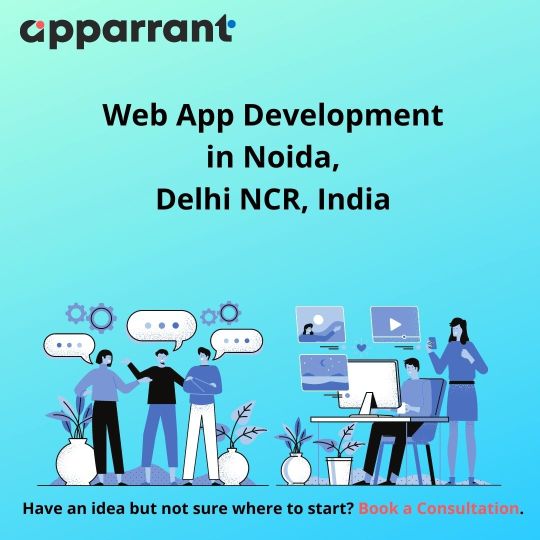#SinglePageApplication
Explore tagged Tumblr posts
Text
Front-End Development: Building the Interface of the Future
Front-end development is at the heart of creating user-friendly and visually appealing websites. It involves translating designs into code and ensuring that web applications are responsive and interactive. In this article, we explore the key aspects of front-end development, essential skills, and emerging trends in the field.
What is Front-End Development?
Front-end development focuses on the user interface (UI) and user experience (UX) aspects of web development. It involves creating the part of the website that users see and interact with, using a combination of HTML, CSS, and JavaScript.
Core Technologies
HTML (HyperText Markup Language): HTML is the foundation of web pages, defining the structure and content, such as headings, paragraphs, and images.
CSS (Cascading Style Sheets): CSS is used to style and layout web pages, controlling aspects like colors, fonts, and spacing to create an attractive and consistent look.
JavaScript: JavaScript adds interactivity and dynamic content to web pages, enabling features like form validation, animations, and user input handling.
Popular Frameworks and Libraries
React: A JavaScript library for building fast and dynamic user interfaces, particularly single-page applications.
Angular: A comprehensive framework for building large-scale applications with a structured and modular approach.
Vue.js: A flexible framework that is easy to integrate into projects and focuses on the view layer of applications.
The Role of a Front-End Developer
Turning Designs into Code
Front-end developers take designs created by UI/UX designers and turn them into code. This involves creating HTML for structure, CSS for styling, and JavaScript for functionality, ensuring the design is faithfully implemented and functional across various devices and browsers.
Ensuring Responsiveness
With the growing use of mobile devices, it’s crucial that websites work well on screens of all sizes. Front-end developers ensure that web applications are responsive, meaning they adapt smoothly to different screen resolutions and orientations.
Optimizing Performance
Performance optimization is key in front-end development. Developers reduce file sizes, minimize load times, and implement lazy loading for images and videos to enhance the user experience.
Maintaining Cross-Browser Compatibility
A successful front-end developer ensures that web applications work consistently across different browsers. This involves testing and resolving compatibility issues to provide a uniform experience.
Implementing Accessibility
Making web content accessible to people with disabilities is a critical aspect of front-end development. Developers adhere to accessibility standards and best practices to ensure that everyone can use the website effectively.
Essential Skills for Front-End Developers
Mastery of Core Technologies
Proficiency in HTML, CSS, and JavaScript is fundamental. Front-end developers must be able to write clean, efficient code that is both maintainable and scalable.
Familiarity with Modern Frameworks
Knowledge of modern frameworks like React, Angular, and Vue.js is crucial for building contemporary web applications. These tools facilitate the creation of complex, dynamic interfaces.
Version Control with Git
Version control systems like Git are essential for tracking changes in the codebase and collaborating with other developers. Mastery of Git allows for efficient project management and collaboration.
Understanding of UX/UI Design
An understanding of UX/UI principles helps developers create user-friendly and aesthetically pleasing interfaces. This includes knowledge of user behavior, usability testing, and design basics.
Problem-Solving and Debugging
Front-end development often involves troubleshooting issues related to layout, functionality, and performance. Strong problem-solving skills are essential to identify and resolve these challenges efficiently.
Emerging Trends in Front-End Development
Progressive Web Apps (PWAs)
PWAs combine the best features of web and mobile applications, offering fast loading times, offline capabilities, and push notifications. They provide a native app-like experience within the browser.
WebAssembly
WebAssembly allows developers to run high-performance code in web browsers. It enables complex applications like games and video editors to run efficiently on the web, expanding the possibilities of front-end development.
Server-Side Rendering (SSR)
Server-side rendering improves the loading speed of web pages and enhances SEO. Frameworks like Next.js (for React) facilitate SSR, making it easier to build fast and search-friendly applications.
Single Page Applications (SPAs)
SPAs load a single HTML page and dynamically update the content as users interact with the application. This approach provides a smoother user experience, similar to that of a desktop application.
Component-Based Development
Modern frameworks emphasize component-based architecture, where UI elements are built as reusable components. This modular approach enhances maintainability and scalability.
AI and Machine Learning Integration
Integrating AI and machine learning into front-end development enables the creation of smarter, more personalized applications. Features like chatbots, recommendation engines, and voice recognition can significantly enhance user engagement.
#FrontEndDevelopment#WebDevelopment#UIUXDesign#HTML#CSS#JavaScript#ReactJS#Angular#VueJS#ResponsiveDesign#WebDesign#UserExperience#WebPerformance#WebAccessibility#SinglePageApplication#ProgressiveWebApp#WebDevelopmentTrends#ModernWebDev#FrontendFrameworks#CodeNewbie#LearnToCode#WebDevCommunity#CodingLife#TechTrends#WebComponents#WebAssembly#ServerSideRendering#DigitalDesign#UIComponents#WebOptimization
3 notes
·
View notes
Text
Harry - Personal Portfolio & Agency Vue Nuxt 3 Template

🐯 Are you looking to showcase your talents and projects in the best light?
Then try our Harry - Personal Portfolio & Agency website for only $29. It’s suitable for Modern Businesses, Layers, Personal Portfolios, Digital Agencies, Startup, Freelancer, Photographer, Architecture, Politician, Vertical Slider any or any kind of portfolio profile🎨💼
You will get here:
💌 Fully responsive and visually stunning design
💌 Built with Vue Nuxt 3 for seamless performance
💌 Modern, sleek, and customizable to fit your unique style
💌 Portfolio and agency-focused functionalities
💌 Easy customization to make it uniquely yours
🔥 Harry website is quite adaptable and looks fantastic on tablets and smartphones. We've incorporated web development best practices, so you can make a fantastic website layout using Grid 1200px or Bootstrap. 🌐🎨
Download Now
#PersonalPortfolio#PortfolioTemplate#AgencyTemplate#VueNuxt3#Nuxt3Template#WebDesign#FrontendDevelopment#CreativeAgency#WebsiteDesign#VueJS#NuxtJS#BlockTemplate#ResponsiveDesign#PortfolioWebsite#VueDevelopment#ModernWebDesign#SinglePageApplication#DesignInspiration#Coding#DeveloperLife#digital marketing#html css#html5#html5 css3#htmlcoding#wordpresstheme#html#business#edtech
0 notes
Text
Single Page Application (SPA): A Comprehensive Guide for Beginners

Welcome to the world of Single Page Applications (SPAs)! This guide is for you if you’re new to web development or just curious about the newest trends in website design. We’ll explain what SPAs are, why they’re so popular, and how they’re altering the way we use websites in this article.
Single Page Applications load everything on a single page, rather than traditional sites, which load new pages from the server. This makes pages more responsive, smoother, and like the applications we use on our phones. We’ll likewise take a gander at the astonishing innovation that powers SPAs, including JavaScript and structures like Angular and React.
Thus, whether you need to develop your site or simply realize what matters to current sites, you’ve come to the ideal blog. We should start this astounding experience of single-page applications!
What is a Single Page Application
A single-page application (SPA) is a web application or site that connects with the user by dynamically rewriting the current page rather than loading entire new pages from the server.
This approach avoids interruption of the user experience between successive pages, making the application behave more like a desktop application. In an SPA, all necessary code – HTML, JavaScript, and CSS – is either retrieved with a single page load, or the appropriate resources are dynamically loaded and added to the page as necessary, usually in response to user actions.
This leads to a faster, more fluid user experience, as information, as opposed to whole pages, is traded with the server. SPAs vigorously depend on JavaScript and frameworks like Angular, React, or Vue.js to handle client-side scripting.
SPAs have been essential for our online experience for quite some time, and many of them are necessary to our everyday digital interactions. To represent this, think about a few notable instances of single-page applications:
Gmail allows you to open, read, mark as unread, compose, send, and delete emails, all within a seamless interface.
Grammarly offers grammar checks and writing suggestions without needing to navigate away from your text.
Google Maps enables you to search for directions or specific places without the need to reload the entire page.
A Brief History Of Single Page Application
The idea of single-page applications (SPAs) has advanced essentially throughout the long term, reflecting more extensive changes in web technologies and user expectations. The excursion of SPAs started with the coming of AJAX (Asynchronous JavaScript and XML) in the mid-2000s.AJAX was a groundbreaking technology that permitted web pages to refresh content powerfully without expecting to reload the whole page. This intended that web applications, like work area applications, could give a more fluid and responsive user experience.
The genuine momentum for SPAs started with the presentation of advanced JavaScript Frameworks and libraries like AngularJS (introduced by Google in 2010), React (developed by Facebook and released in 2013), and Vue.js (created by Evan You in 2014). These tools made it a lot simpler for developers to construct perplexing, effective, and versatile SPAs.
The rise of HTML5 and CSS3 also played a crucial role, offering more powerful and flexible ways to structure and style web content. Features like local storage, session storage, and history API were particularly important in enhancing the capabilities of SPAs.
Over time, SPAs have become synonymous with modern web experiences, allowing for seamless interactions and transitions, much like native apps. They are particularly popular for building complex, interactive websites and applications like social media platforms, e-commerce sites, and cloud-based software, where user experience and performance are paramount.
What is Single Page Application Architecture? How Does It Work?
Single Page Application (SPA) architecture alludes to how these applications are structured and the way that they work to convey dynamic web content. Dissimilar to traditional web applications, which reload the whole page from the server at whatever point another piece of content is mentioned, SPAs load all the vital HTML, CSS, and JavaScript code with a single page load.
After this underlying stacking, the SPA progressively refreshes the page with new content from the server, creating a more seamless and interactive user experience.
How Single Page Application Architecture Typically Works
Initial Page Load: When the user first requests the SPA, the server sends the essential HTML, CSS, and JavaScript. This includes the structure, styling, and functionality required for the web page.
Browser Rendering: The browser renders this initial page, and the JavaScript creates the application’s structure and logic. This setup lays the groundwork for all subsequent interactions.
User Interaction: When a user interacts with the application (like clicking a link or button), the JavaScript intercepts these browser events. Instead of sending a new request to the server for a full page, JavaScript handles these interactions.
Data Handling: For any new data needed (like loading a new set of items in a list), the application makes AJAX calls to the server. The server returns the requested data, typically in JSON format.
Dynamic Content Update: The JavaScript updates the webpage dynamically with the new data. This is usually done using a JavaScript framework or library, which efficiently handles the Document Object Model (DOM) manipulations to update the content.
Browser History Management: SPAs use the HTML5 History API to update the browser’s history log. This makes it possible for users to use back and forward buttons, bookmark pages, etc., even though new pages aren’t being loaded in the traditional sense.
Advantages of Single Page Application
Single Page Applications (SPAs) offer several advantages that make them a popular choice for modern web development:
Single-time File Load for HTML, CSS, and JS
All essential files (HTML, CSS, JavaScript) are loaded once at the start of an SPA. This implies that the browser does not have to reload the entire page for each user activity, which reduces loading times and improves user experience.
No Extra Queries to Server
After the initial load, SPAs do not require additional page reloads from the server. Any new data needed is fetched using AJAX calls, which only transmit relevant data instead of entire pages.
Functionality in Disrupted or Offline Conditions
SPAs can continue to function even in unstable network conditions or offline, as much of the necessary information is already loaded and stored in the browser.
Fast Processing
Since SPAs only update the required content instead of reloading entire pages, users experience faster interactions and more immediate feedback, which is particularly noticeable in complex applications.
Cross-Platform Compatibility
SPAs are inherently cross-platform apps as they run in web browsers, which are available on virtually all devices and operating systems. This makes them easily accessible across different platforms.
Quick Development
The development process for SPAs can be quicker and more streamlined, as developers can focus on a single-page application rather than handling the complexities of multiple page reloads and navigations.
Chrome-based Debugging
SPAs are typically developed using modern web technologies that are well-supported by Chrome’s developer tools, allowing for efficient debugging and testing directly in the browser.
Top Frameworks for Single Page Applications
ReactJS: ReactJS, created by Facebook, is a declarative, efficient, and adaptable JavaScript library for creating user interfaces. It is well-known for its component-based architecture and virtual DOM functionality, which improves efficiency.
AngularJS: Created by Google, AngularJS is a structural framework for dynamic web apps. It extends HTML with new attributes and binds data to HTML with expressions. AngularJS is known for its two-way data binding feature.
EmberJS: EmberJS is an open-source JavaScript web structure in light of the Model-View-ViewModel (MVVM) pattern. It permits developers to make versatile single-page web applications by incorporating best practices into the framework.
BackboneJS: BackboneJS gives structure to web applications by furnishing models with key-value binding and custom events. It’s known for its lightweight and effortlessness, making it an extraordinary decision for projects where you probably won’t require the greater highlights presented by different frameworks.
VueJS: VueJS is a free and open-source JavaScript model-view-viewmodel front-end framework for creating user interfaces and single-page applications. It is intended to be adopted gradually and emphasizes simplicity and adaptability.
Meteor: Meteor is a full-stack JavaScript platform for developing modern web and mobile applications. It includes a key set of technologies for building connected-client reactive applications, a build tool, and a curated set of packages from the Node.js and general JavaScript community.
Polymer: Developed by Google, Polymer is a lightweight library to develop web-based applications. It helps in creating custom reusable HTML elements and using them to build performant, maintainable apps.
Aurelia: Aurelia is a modern front-end JavaScript framework for building browser, mobile, and desktop applications. It focuses on aligning closely with web platform specifications, using adaptive techniques to stay as efficient as possible.
Handpicked Posts: Top 20+ React Libraries
Single Page Application Examples
Gmail: Google’s email service, Gmail, is a classic example of an SPA. It allows users to interact with their emails (read, send, delete, etc.) without the need to reload the entire page, offering a seamless user experience.
Google Maps: This popular mapping service by Google is another SPA. Users can search for locations, get directions, and explore maps without traditional page reloads, making the experience smooth and efficient.
Facebook: The social media giant uses SPA principles to update users�� feeds, notifications, and messages in real-time, without the need for full-page refreshes.
Twitter: Twitter’s interface, where users can scroll through tweets, interact with them, and post new tweets, operates as an SPA, providing a dynamic, real-time user experience.
Airbnb: The popular accommodation booking platform employs SPA architecture for its seamless searching, booking, and listing management functionalities.
GitHub: The web interface of GitHub, a platform for version control and collaboration, functions as a SPA, especially in repository management and issue tracking.
Netflix: As a streaming service, Netflix uses SPA principles to allow users to browse through movies and series, manage their accounts, and watch content without traditional page refreshes.
Pinterest: Pinterest operates as a SPA, where users can browse, pin, and manage content in a highly interactive environment without full page reloads.
FAQs About Single Page Applications
1. Is Instagram a single-page application?
Yes, Instagram is a single-page application, offering dynamic content loading for a seamless user experience.
2. Is Facebook a single-page application?
Yes, Facebook is a single-page application, especially in how it updates feeds and user interactions without full-page reloads.
3. Why is React called a single-page application?
React is often used to build single-page applications because it efficiently updates and renders components without reloading the entire page.
4. Can I use SPA with CMS?
Yes, you can use a SPA with a Content Management System (CMS); modern headless CMSs are particularly well-suited for integration with SPAs.
Originally published by: Single Page Application (SPA): A Comprehensive Guide for Beginners
1 note
·
View note
Text
#ReactJS#JavaScript#FrontEndDevelopment#WebDevelopment#ReactDeveloper#ReactComponents#UIDevelopment#JSX#SinglePageApplication#ReactNative#CodeComponents#ReactState#ReactHooks#WebDev#ReactJSCommunity#ReactCode#ReactApps#DeveloperLife#ReactUI#TechInnovation
0 notes
Text
Integrating Angular 19 with a Laravel API is a powerful way to build a scalable and modern web application. Angular serves as a dynamic frontend framework, while Laravel provides a robust backend with an elegant API structure. In this guide, we’ll go through the best practices for securely and efficiently connecting Angular with a Laravel backend, ensuring smooth communication between both frameworks.
#Angular19#Laravel#APIIntegration#Angular#LaravelAPI#WebDevelopment#FrontendDevelopment#AngularApp#RESTAPI#FrontendBackendConnection#AngularDevelopment#WebAppDevelopment#LaravelBackend#AngularServices#APIRequests#AngularBestPractices#LaravelDevelopment#JWTAuthentication#CORS#WebAppArchitecture#AngularRouting#BackendIntegration#SinglePageApplications#SPA#AngularFrontend#LaravelFramework#AngularLaravel#FullStackDevelopment
0 notes
Text

🚀 Elevate Your Web Development with Dedicated AngularJS Developers! 🌟
Are you looking to create robust and scalable web applications? Discover how hiring dedicated AngularJS developers can transform your projects! From building dynamic single-page applications to integrating real-time features, AngularJS offers endless possibilities.
💡 Learn More About:
The benefits of AngularJS for web development
Key features that make AngularJS a top choice
How to effectively hire skilled Angular developers for your projects
🌐 Read the full article now!
https://hire-dedicated-angularjs-developer.onepage.website/
0 notes
Text
🚀 Unveiling Angular.js: A Robust Front-End Framework 💻
Angular.js, developed and maintained by Google, is a comprehensive JavaScript framework widely used for building dynamic single-page applications (SPAs). With its strong community support and powerful built-in tools, Angular.js continues to be a go-to solution for developers aiming to create scalable, maintainable, and testable applications. Here’s why Angular.js stands out:
🧩 Component-Based Architecture
Like React, Angular uses a component-based architecture, allowing developers to break down the UI into reusable components. This modularity makes the development process more organized, with better separation of concerns, enabling faster development and easier maintenance.
🔁 Two-Way Data Binding
One of Angular.js' key features is two-way data binding, which synchronizes the model and the view in real-time. When the data in the model changes, the view is automatically updated, and vice versa. This seamless data flow reduces the amount of boilerplate code and improves the overall developer experience.
📦 Directives
Angular.js introduces custom HTML tags and attributes called Directives, which extend the functionality of HTML. With Directives, developers can create dynamic and reusable components that enhance the interactivity and structure of web applications without cluttering the codebase.
🚀 Dependency Injection
Angular.js uses dependency injection, making it easier to manage and test the relationships between components and services. This design pattern promotes code reusability and maintainability by decoupling components, leading to cleaner, more modular applications.
⚡ Angular CLI and Built-In Tools
Angular.js comes with a powerful Command Line Interface (CLI) that simplifies the setup, testing, and building processes. With built-in tools for routing, HTTP client handling, and form validation, Angular provides developers with everything they need to build and deploy a modern web application from start to finish.
Contact Information:
Address: Dr Rajendra Prasad Road, Udumalaipettai, Tamil Nadu-642126
Phone number: +91 82706 61266
Email : [email protected]
Website: https://grapinz.com/
Instagram: https://www.instagram.com/grapinz/
G-Map: https://maps.app.goo.gl/WHq7AQ2QsWQBrBTWA

#AngularJS#JavaScript#FrontendDevelopment#WebDevelopment#TechCommunity#WebDev#SinglePageApplications#UIUX
1 note
·
View note
Text
Leverage Angular.js for Feature-Rich Single Page Applications
Devstree Canada, a leading Angular.js development company, helps businesses build dynamic and scalable Single Page Applications (SPAs) since 2013. Their expertise in Angular.js's MVC architecture, dependency injection, and data binding empowers them to create custom web applications that meet your specific needs and drive business growth.
#AngularJS#WebDevelopment#SPAs#SinglePageApplications#Canada#Devstree#SoftwareDevelopment#JavaScript#WebApps#MVC#DependencyInjection#DynamicWebApps
0 notes
Text

2022年4月~2024年9月
アイ・モバイル株式会社
自社開発BtoB向けWeb構築CMSであるSmartpageのUI/UX、刷新版、同様CMSのSuportWebSite、自社採用WebSiteであるらくらく採用、新規特定職種採用WebSite ※全て一般非公開のため企業WebSiteのリンクのみ掲載
BtoB向けノーコードWeb構築CMSを主に扱うIT・通信会社にて、BtoB向けノーコードCMSのUI/UXデザイン、コーディング、フロントエンドデバッグ・総合テスト・単体テスト等の開発側支援、社保有サポートWebサイト等の改修・デザイン業務、UI意見提案、制作進行全般に関わっておりました。
●経験
HTML CSS/Sass/Stylus JavaScript Illustrater Photoshop AdobeXD Figma
フロントエンドコーディング ディレクションアシスタント レスポンシブデザイン デザイナーとの連携 コーダーとの連携 制作進行管理
・UI/UX画面の一例 開発NoCodeCMSのWeb管理用UI/UX

Web集客結果の一覧からアクセス解析、決済機能付きFormの設定までWebSiteの集客結果を一元管理できるUI/UXのコーディング、デザインを行っておりました。
・UI/UX画面の一例 開発NoCodeCMSのWeb編集用UI/UX

実際のWeb画面を閲覧しながら画像の挿入、決済機能付きFormの作成、WebPage管理等一元編集できるUI/UXのコーディング、デザインを行っておりました。
そのほかSPA(SinglePageApplication)や自社保有BtoB向けSiportWebSite、既存のCMSの新規刷新のUI/UXの考案、コーディング、特定職種の採用WebSiteの立ち上げの補助等にも合わせて関わらせて頂いておりました。
0 notes
Text
Mithril JS Overview
Mithril JS Overview In this article, we'll see Mithril.js Overview. In the ever-evolving world of web development, Mithril JS stands out as a friendly and powerful companion for developers. Learn More : https://phptutorialpoints.in/mithril-js-overview/ #php #phptutorial #phptutorialpoints #webdevelopment #webdevelopmenttutorial #mithriljs #mithriljsdevelopment #mithriljstutorial #whatismithriljs #javascript #javascriptdevelopment #javascriptframeworks #jsframework #singlepageapplication
In this article, we’ll see Mithril.js Overview. In the ever-evolving world of web development, Mithril JS stands out as a friendly and powerful companion for developers. This lightweight JavaScript framework has been steadily gaining popularity for its user-friendly nature, performance, and elegance. With Mithril JS, developers can effortlessly create robust and responsive web applications while…

View On WordPress
0 notes
Text
How to Build a Single Page Application?
What is Single page application? It is a just web application which render javascript code directly. Many companies nowadays moving on single page application such as META or FACEBOOK, Instagram, Airbnb, Gmail, Paypal, Github and many more.
0 notes
Text
Single Page Applications vs Multiple Page Applications: How to Make a Choice? We’re proud that our very own founder is contributing to Geelong’s bright future.
0 notes
Photo

Get the Best Web App Development in Noida, Delhi NCR, India. . We develop applications that breathe life into your devices. . For more follow us. Visit: https://apparrant.com/services/mobile-and-web-application-development/
#webapp#appdevelopment#mobileappdevelopment#progressivewebapp#singlepageapplication#apparrant#apparranttechnologies#applicationdevelopment#appdevelopers#apptunix#appdevelopersnearme#appbuilders#webappdevelopment#appweb#officewebapps#topappdevelopers#appprogramming#websiteapplication#webapplicationslist#bestappdevelopers#applicationdesigner#bestmobileappdevelopers#uxagency#uiagency#uxuidesigner#uxandui#uxanduidesign#uiuxdesignagency#uiuxdesigncompany#uxdesignagency
0 notes
Text
Upgrading an existing Angular project to Angular 19 ensures better performance, security, and new features. However, upgrading requires careful planning to avoid breaking changes. This guide will walk you through updating dependencies, testing compatibility, and fixing issues in a structured way.
#Angular19#StandaloneComponents#ModularArchitecture#Angular#WebDevelopment#FrontendDevelopment#AngularComponents#AngularModules#AngularDevelopment#AngularApp#WebAppDevelopment#AngularBestPractices#CodeOrganization#ModularDesign#FrontendArchitecture#ComponentDesign#AngularFeatures#WebAppStructure#ComponentReuse#AngularServices#WebComponents#AngularAppStructure#DynamicComponents#SinglePageApplications#AngularDesignPatterns
0 notes
Text
Single-page applications work in the browser and do not need to reload the page or additional waiting time. Since the content is downloaded automatically, there is no need to refresh the page. We use these types of applications every day. Think about Facebook & Netflix. These are good examples of single-page applications.
SPAs use AJAX and HTML5 to create responsive applications. JavaScript frameworks such as Angular, React, Vue, and Ember handle the heavy lifting on the client-side of a single-page application.
The page will not be reloaded at any point in the process, nor will control be transferred to an alternate page, although the HTML5 history API or location hash can be used to provide navigability and insight into different logical pages in the web application.
Read More:-https://www.jellyfishtechnologies.com/single-page-application-spa.html
0 notes
Photo

Want to know what are the prons cons of single page applications and it’s real life examples ?
With the drastic increase in the pace of technology and reduced rate of customer attention span, it is important to become more customer-centric and look out for ways to engage potential customers. Therefore, there is a leading paradigm shift towards single-page applications.
0 notes